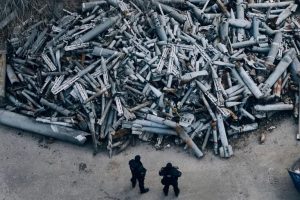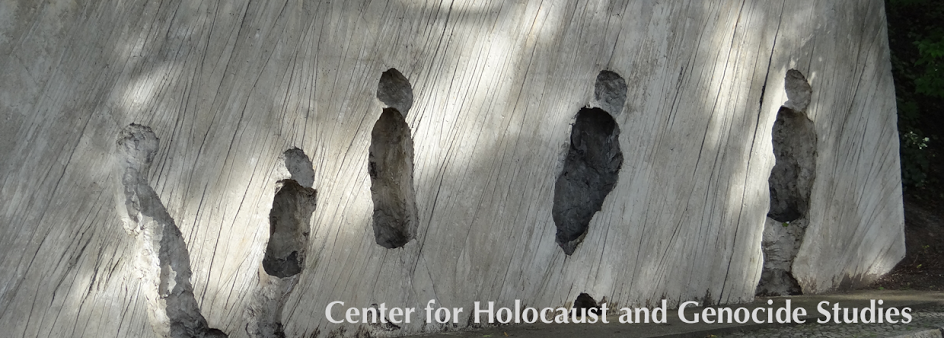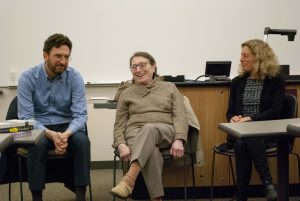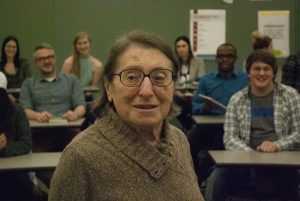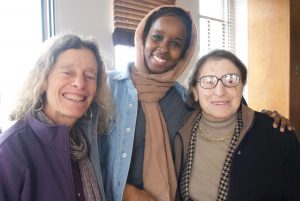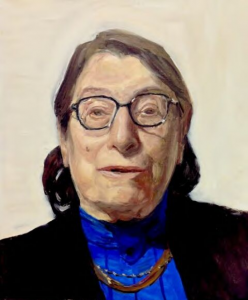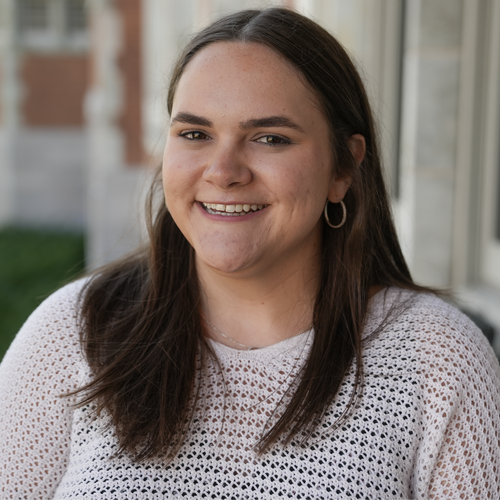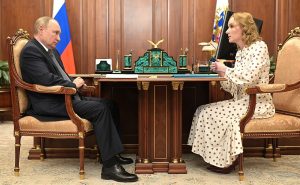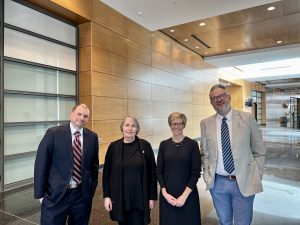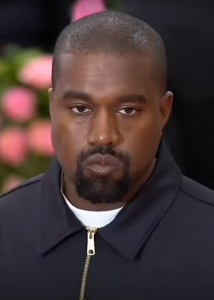The first month of the calendar year happens to include the first of many events to remember the victims of genocide perpetrated by the Nazis and their collaborators. Various events occur around the world, in numerous languages, and have their origins in different geographies, political ideologies, and cultural-linguistic milieus.
But like every year—for personal and professional reasons—deciding what to say for International Holocaust Remembrance Day (January 27th) or the more Zionist-laden Yom Hashoah (April 18th), while avoiding what hasn’t already been said, is a challenge. Personally, and as a Jew, I certainly “remember” in a diverse set of ways, and I openly talk about these practices. From regular write-ups for the Center in my professional capacity, to the reading group I run with former students—as we read Yiddish literature in the original on a weekly basis—individual and collective memory acts take place.
But every year, coterminous events and life experiences inevitably end up shaping the direction of these memory acts, too. This year was no exception.
The Center for Holocaust and Genocide Studies often receives requests to contextualize historical figures, events, etc. pertaining to episodes of genocide and mass violence. Although meaningful outreach work, I experience immense frustration (that I suspect will only increase over time)—at not only the ways that firsthand accounts of genocide survivors are confined to archival sources, but also at how a siloing of approaches to the subject matter erases meaningful connections—not only to the present but also to marginalized stories left untold. Without memory politics (and certainly without historiography—or, the study of the study of history), what are left are universalizing narratives we pretend are divorced from a particular moment in time and locale.
Furthermore, this universalizing tendency often asserts overly moralistic stances (i.e., “we teach about X individual or X event, because it teaches us to do/not do Y [moral lesson]”), which rarely take into account the very real, complex, individualized, and human grappling with the past, which I argue is vital to pedagogy, research, and outreach.
There is of course understandable hesitance from educators, community and religious leaders, etc. (and even academics) to address what are deemed the more difficult, perhaps “political” or controversial dimensions of a particular “subject” (i.e., a person, an event, etc), namely how certain actions or events in the past might not be confined to the past after all, and what are the moral complexities of human in/action. It is all too easy to cherry pick the details around particular people, places, and events, especially if we did not take part in someone’s actions, witness the events as they occurred, or take part in an event’s implementation. However, simply viewing events within a well-defined, well-confined historical vacuum (and with ingrained and unexamined biases) often leads to rigidly deciding whom (and what) gets highlighted about events half a world away. In turn, more inclusive, more nuanced, and more personal(ized) approaches are often shut out.
To be clear, I am certainly not advocating for introducing the full breadth of a particular subject “too soon” in a student’s career; there are obvious reasons why such approaches would be unacceptable. I should also be clear here, that a “moralistic” element of history instruction is not what I solely take issue with. Of course, one of the reasons we study the past is to see how it directly implicates us in the present. There is much to glean from this rationale. At the same time, as well-intentioned as these approaches may be, teaching a particular subject that is full of morally complex actors, while also pretending we can “safely” confine the subject matter culturally, temporally, and geographically to another time and place, both advertently and inadvertently prevents a needed, individual(ized) response, and the needed responsibility to grapple with our own subjectivity. This is certainly why the study of historiography is so important, to ensure that we see how the “study of the study of history” has changed across time and space. Furthermore, we learn to understand what narratives might have been left out, and how those ellisions or changes have in turn been cemented structurally.
The way we teach (and don’t teach) something, as it is directly linked to a lack of historical memory and historiography, has direct implications—certainly for the current political climate in the United States—and for what has unfortunately been coined the “culture wars.” The consequences of weak leadership in many of our country’s vital (but weakened) democratic institutions, a public distrust of experts, the decline of governmental regulation regarding civil rights and liberties, and longstanding bigotries have all merged to now threaten the bodily autonomy of millions when it comes to racial and gender justice, as well as sexual autonomy. We have seen this recently with current attempts nationwide to silence ethnic studies proponents, who are reframing the orthodoxies of US history to finally center marginalized voices—notably regarding slavery and the ongoing genocide of indigenous groups.
Similarly frightening effects of our current moment also include the increasing restrictions to abortion access that have been passed on state levels at alarming rates, something that had been occurring for years even before the Dobbs vs. Jackson Women’s Health Association decision. The anti-trans and anti-drag bills entering legislative dockets across the United States are too numerous to count.
It’s thus not only important that we as scholars/educators convey how these battles for equality have yet to be “won” outright (even with victories there have been setbacks in the fight for equality). We should also be getting students of all ages (and that includes members of the general public) to see what parallels (and what differences) exist in their own lived experiences, and in turn how this denial of human rights implicates them.
Although I am not the first scholar to point out the problems educators, marginalized groups, and activists in the United States are facing when teaching histories of racial and gender justice, sexual autonomy, and LGBTQ+ rights, I am also concerned—as someone largely working outside American and Anglophone spheres—that the distorted study of our own past absolutely shapes the way Americans learn about the rest of the world (or don’t). As noted historian Dominique Kirchner Reill has recently written, it would be naive to think that the backlash against the teaching of various subjects, the banning of books, etc. in United States K12 schools in 2023 does (and will) not affect the ways students study and address global histories and cultures.
A critical intervention of some kind against these measures will by no means be a cure-all for the ongoing structural and moral ills of the United States (i.e., voter disenfranchisement, structural racism, the stripping of bodily autonomy and individual rights, healthcare or lack thereof, etc). However, I argue that, it is for this very reason that we must highlight more personal experiences that push back against universalizing narratives, to instead map out the needed ethical frameworks we need right now, and in real time. I sadly fear these more personalized narratives are even more imperiled due to the very structural and moral issues I hint at. Without these narratives, however, we will individually and collectively fail to expand (much less retain) rights achieved through hard-won battles.
How does this play out when discussing historical events of genocide and mass violence, particularly at the K12 level, but also at the university level? For the remainder of this essay, I will reflect on several examples that I hope will shed light on some of the paradigm shifts I am advocating for.
“To Be Human in History”
It was both odd and fortuitous timing that I recently rediscovered a post by Angelika Bammer, Professor of Comparative Literature at Emory University. Prior to the COVID-19 Pandemic, Bammer visited the University of Minnesota to speak about her recent book, Born After: Reckoning with the German Past (Bloomsbury, 2019). Bammer writes, “to be a human in history” is to understand how the pasts we inherit (but do not directly experience) shape the self. Bammer, born to German parents in the immediate aftermath of World War II, saw how the Nazi years shaped her life (and her children’s), even if she had not been alive to witness them herself. Also significant, is how Bammer notes the central role of feminist theory in her work, not only in how lived experiences and “the personal” are central to her own scholarship, but how feminist theory itself provides analytical toolkits for “emotionally honest” scholarship — “a dimension of rigor that conventional scholarship all too seldom lacks.”
This dimension of rigor that Bammer cites is in fact a central role of the humanities in academic scholarship—whether those in STEM and the social sciences find value in it, or not. This does not mean that the humanities have nothing to answer to, historically speaking. Many personal, lived experiences remain largely invisible in the majority of these fields, and are still structurally excluded from sites of power within higher education (including from the apparatuses governing tenure). I certainly implicate the humanities as a whole for these deficits. The concern that I have, however, stems from the continuing derision, dismissal, and underfunding of the arts and humanities. If humanities fields are not around to value the personal, what segment of academia actually will?
The answers to this question have direct implications to the study of history, as well as the nature of our society as a whole. It is not only a “dimension of rigor” that we forfeit at all levels of education without key awareness of the personal; as educators we also relinquish the responsibility to reshape our professions, our fields, and our world with necessary critical voices and new approaches, and in turn: we forfeit the responsibility to reshape outdated, immoral, and unjust systems. If students are already entering college and are often unaware of the world(s) that they have inherited, and of their own political and ethical agency surrounding the past (especially when it comes to race, gender, and sexuality), where and when do we rectify this, and when teaching about instances of genocide and mass violence later on?
“The Unethical and the Unspeakable”
Before I continue, I must say that it is not simply my Jewishness that informs my own approaches to teaching, outreach, etc. regarding genocide and mass violence. It is also my queer identity as a gay man that profoundly shapes my own approaches to German Jewish and Yiddish literatures and cultures, and in turn minority language rights and visibility when discussing comparative topics within Holocaust and Genocide Studies. I am constantly at odds with the US public’s unspoken orthodoxies around these subjects, in the ways these orthodoxies erase pre-World-War-II Jewish cultures and politics beyond Zionism, as well as gender and sexuality in memory politics. It is indeed acknowledging “the personal,” which confronts these orthodoxies and transgressively subverts forms of scholarly and cultural (including racialized, gendered, and heteronormative) gatekeeping that are also in academia.
We can all work outside given norms and buck any orthodoxies we so wish, but other, more sinister forms of gatekeeping at sites of power will often silence these attempts. It is at these moments, when gatekeeping is most pronounced, and in this historical epoch in which we find ourselves that we should be cognizant of the actual lessons we need to be teaching.
These reflections came to a head when I attended a talk via Zoom at the Dornsife Center for Advanced Genocide Research at the University of Southern California. Carli Snyder (PhD Candidate at CUNY Graduate Center and Visiting Research Fellow at the USS Shoah Foundation) gave a brilliant talk entitled, “Questions of Gender and Sexuality in Interviewer Trainings and Holocaust Survivor Testimonies.” What Snyder, through her groundbreaking and important intervention has made clear, is that histories of genocide are not universal, nor are they confined to set start and end dates, and the traumatic effects of such moments are not confined to one particular generation of eyewitnesses. Instead, it is up to scholars, educators, students, and activists to grapple with what histories emerge anew through greater contextualization of the objects in question, and namely with the ways gendered histories of violence are central to eyewitness testimony.
For Snyder, the “objects” not only include oral history interviews that were conducted for the Visual History Archive, but how they were conducted for an archival repository such as the VHA, when they were conducted (i.e., the individual and collective moment between 1995 and 1998 when the bulk of the VHA interviews were recorded), who conducted them, and what the subjects discussed. These might seem like obvious research questions that have long been answered, but Snyder (and many others including myself) can assure you that they have not; universalizing narratives have a way of erasing particularities, and obscuring the very political nature of historical objects as they speak to us today. Furthermore, attempts to give voice to “the particular” (i.e., through civil rights, gender equality, and so forth) are, as I have argued, ongoing and not at all a given in our current moment.
For example, Snyder is researching the work of Joan Ringelheim, who was and remains a pioneering figure in the collection of Holocaust testimony. Snyder demonstrated how Ringelheim was one of the first to point out in the 1980s that Holocaust histories were often “condensed” into a “universal” or “gender-neutral” framework, or a “universal human perspective,” and did not take into account the differences in experiences according to gender. First as an independent scholar and later at the Holocaust Memorial Museum as Director of the oral history division, Ringelheim coined what she called “the Unethical and the Unspeakable,” which she had presented on at a conference, “Women surviving the Holocaust” in 1983. Ringelheim conducted circa 20 interviews in the late 1970s and early 1980s with women survivors, who addressed issues such as sexual assault, strategic sexual relationships, pregnancy, abortion, menstruation, and sexuality.
During her talk, Snyder showed how the format of Ringelheim’s interviews was one of collaboration and exploration—on the part of both the interviewer and the interviewee. Ringelheim’s groundbreaking approach to documenting the oral histories of women was, however, only one dimension of an intervention that is still continuing; Snyder sees this when some of Ringeheim’s interviewees later provided oral histories for the Shoah Foundation in the 1990s, and in turn how markedly different they were. Rarely do subjects interviewed by Ringelheim mention with the Shoah Foundation the experiences they had pertaining to gender and sexuality. Not to mention, if survivors ended up providing information about their gendered experiences, the sexual violence they were subject to, or anything about their sexuality in general, it often came through the interviewee volunteering the information — not on behalf of the interviewer conducting the oral history.
This should immediately raise numerous questions for scholars, educators, and students. What do we make of an archival record of oral histories and testimonies that, though extensive, has left out, excised, deemed less valuable, etc. certain topics and human subjects according to gender and sexuality? The Visual History Archive, for example, contains over 50,000 interviews with survivors of genocide and mass violence, survivors who are the subject of not only their VHA interview, but likely other interviews, public talks, etc. Although an incredibly rich archive that generations of scholars will certainly be researching, it should be made apparent that these interviews are simply not static “objects;” they are the very real products of “the personal.” Taking this into account, how then does gender and sexuality more broadly factor in (or not) to these 50,000+ interviews? And the ways histories of the Holocaust are taught more broadly? What might we glean if we take a deeper dive into the material? Can we discuss and teach with these materials differently?
Queer Intergenerational Trauma
Also around the time Snyder’s talk took place, I stumbled upon an article on social media from The Advocate concerning the German Bundestag’s recognition of LGBTQ+ victims by the Nazis on International Holocaust Remembrance Day. Although this was not the first time a German government official acknowledged Queer and Trans victims of the Nazi regime, the President of the Bundestag acknowledged, publicly for the first time, that Germany’s collective memory culture has a responsibility in acknowledging the histories of all groups persecuted by the Nazi state.
These are fairly recent developments within a larger, complicated (and contested) past. It was only in 2017 that the German government annulled the convictions of 50,000 homosexual men tried by the Nazis, as well as those tried and convicted in the postwar (West German) era under Paragraph 175. The annulment finally made victims of persecution under the law eligible for reparations. Unfortunately, many men who had been convicted had passed away by that time. Furthermore, accounts from individuals persecuted for their sexuality by the Nazis and in the postwar Germanies are sparse. According to this German-language documentary approximately 80% of men sent to concentration camps for homosexuality (5,000 – 15,000 men) did not survive the camps at all, having faced brutal treatment by guards and other inmates alike.
The Nuremberg Trials had also refused to address crimes against homosexual men due to the Paragraph 175’s continued enforcement after 1945 (and those found guilty under the Nazis remained imprisoned). As a result, Holocaust and Genocide studies research took decades to give this topic its due. Although anti-sodomy laws largely targeted same-sex relations between men, lesbians in Imperial, Weimar, Nazi, and postwar Germanies (particularly in West Germany), also faced incredible oppression due to deeply sexist and patriarchal norms governing society. The experiences of lesbians who faced discrimination and erasure, and whose lives were also destroyed in various ways from the 19th century onward, remain understudied. Histories of those who today would identify as trans and non-binary, who were often the subjects of early sexology, hardly exist in the secondary literature at all. These norms also largely erased women’s sexuality from public discourse as a whole. Not to mention during the Nazi era, racial hierarchies and misogyny restricted women’s sexual autonomy completely.
Even as homosexuality was partially decriminalized in both East and West Germany by the late 1960s, only political activism over multiple decades led to recognition of the persecution under the Nazis and in the postwar era. The Nazis further strengthening of Prussian-era Paragraph 175 in 1935, the flight of many queer and trans people from Germany after 1933 facing marginalization elsewhere, and West and East Germany’s further criminalization of homosexuals who remained imprisoned after the war, demonstrates how histories of persecution are fluid, and continue to affect subsequent generations. It should not be surprising that, like with gendered differences in experience of genocide survivors, the uneven (and often invisible or unavailable) archival record regarding (Queer) sexuality is structural in nature, also.
So back to Snyder: in her talk, Snyder cited a profound example that illustrates many of these histories, which lie within oral testimonies just beneath the surface. Language politics and code switching (for those studying minority language politics), Jewish migration within Europe, the role of communal organizations for Jews living in poverty, etc. all appear in Rachel Goldman Miller’s testimony within the first segment of the oral history interview. These dimensions of the testimony could be discussed at length. However, Goldman Miller’s experiences, as they relate to Snyder’s talk on gender and sexuality, are (though graphic) also vital to her story.
Goldman Miller was adopted by an American Jewish soldier, who sexually molested her. Goldman Miller was then kicked out of the house after the soldier’s wife discovered the abuse, and was sent into foster care. In her interview, conducted in 1994, Goldman Miller recounts these instances of sexual abuse and exploitation in her own words, and in turn how these episodes fit into a larger history of her trauma, both personal and collective regarding gendered experiences of genocide.
Also striking are the ways that Goldman Miller threads other familial details into her oral history (e.g., details about her grandchildren) before suddenly interjecting to say: she “had a second Holocaust.” Viewers of the oral history will have noticed that Goldman Miller wears a ribbon from the AIDS Walk Los Angeles. It is here that Goldman Miller mentions her son, Mark, who had died of AIDS complications two years prior, and who becomes the subject of his mother’s interview for over 20 minutes. It is this traumatic episode that Goldman Miller goes on to say (again) that her son’s death was “her second Holocaust.” It is clear that Goldman Miller struggles to continue with her “testimony” without first going into further details about her son’s life, and how she and her husband cared for him up until the moment he passed away.
It is incredibly important to recognize that, had the interviewer not allowed Goldman Miller to continue uninterrupted, this particular narrative would be absent from the archive today.
It is profound for a Holocaust survivor to say in her oral testimony that, “[HIV/AIDS] is another Holocaust that we have to do something about; there are many kinds (Tape 4, 27:32).” We should sit with the uniqueness of this statement. This is not only an important dimension to the interviewee’s story pertaining to the Holocaust; the history of HIV/AIDS activism and familial support that comes to light is significant, considering that many who fell sick and died faced intense marginalization from their families, their employers, etc. Goldman Miller goes on to also mention the Rwandan Genocide, taking place coterminously with her interview, which is an important reminder to 2023 viewers that Holocaust survivors were not viewing their own histories in a vaccuum.
If survivors of genocide are making these parallels, why aren’t we? Why are we siloing the narratives pertaining to the Holocaust from other genocides? What is our responsibility as listeners, researchers, instructors, and students?
This interview is a horrific example of the difficult subject matter often left out of universalized histories of genocide, but it also uncovers the ways in which an interviewee such as Goldman Miller writes her son into her own narrative, into a history that he did not witness but perhaps felt to some extent as a child of a Holocaust survivor and a gay man (as others with those lived experiences did). And in turn: Goldman Miller writes herself into that of her son’s history of marginalization and mass death. This is apparent when Goldman Miller goes through photographs (a common and incredibly rich element to the Visual History Archive interviews) depicting her family (including of her children and grandchildren), relatives who were murdered during the Holocaust, gravestones in Paris with French and Yiddish inscriptions, etc. For those familiar with the Visual History Archive, material objects often enter into the interviews, and Goldman Miller includes her son’s panel from the AIDS Quilt into the recording, thereby entering into a larger historical narrative and dialogue regarding state violence and and public inaction toward marginalized groups.
I have published past blog articles for CHGS related to Queer and Trans histories, and the politics of memory during the AIDS crisis. As activists in the 1980s and 1990s (many of whom happened to be related to Holocaust survivors) saw parallels to their own lived experience as they refashioned and reclaimed symbols, such as the rosa Winkel (pink triangle) for their own use, and pointing out that the past is not only in the past. If one thinks about how the majority of the VHA interviews were conducted in the mid-1990s, one can only surmise how other genocide survivors hint at and refer to other global conflicts and instances of genocide occurring around that time. How can we possibly, and ethically, confine the Holocaust to 1933-1945? And more importantly, how can we continue to separate out these events separate from one another when memory links them together?
I am certainly not advocating for reductive, side-by-side comparisons when teaching about episodes of genocide and mass violence. But how can we better include topics around race, racism(s) and racialization, gender, and sexuality when we teach about historical events—as they connect us to our pasts, and especially as they circulate in survivor narratives we teach in our classrooms? What are survivors saying to, and about, us?
What I propose as a simple starting point, is to always view our focus on specific historical events through the lens of our contemporary world and its politics—not as a depoliticized figment of a distant time or place. Students should then think about: what politically is taking place both in the United States and globally? Why should we (really) be studying this topic in 2023? What orthodoxies might need to be placated for more inclusive studies of such events—and not only of the events themselves, but also of ourselves, as we are responsible for grappling with this subject matter? Although historical narratives elsewhere might differ from what we encounter in the United States, race, (and, to echo Snyder) gender, and sexuality are embedded in survivor narratives about the Holocaust, and we are ethically responsible for making sure that that embeddedness is discussed and centered.
Select Academic Resources:
Hájková, Anna. ‘Den Holocaust queer erzählen,’ Sexualitäten Jahrbuch, 2018, pp. 86-110.
Huneke, Samuel Clowes. “Heterogeneous Persecution: Lesbianism and the Nazi State,” Central European History 54.2 (2021): 297-325
——. “Death Wish: Suicide and Stereotype in the Gay Discourses of Imperial and Weimar Germany” New German Critique 46.1 (1 February 2019): 127-166.
——. States of Liberation: Gay Men between Dictatorship and Democracy in Cold War Germany. Toronto: University of Toronto Press, 2022.
Marhoefer, Laurie. Sex and the Weimar Republic: German Homosexual Emancipation and the Rise of the Nazis. Toronto: University of Toronto Press, 2015.
——. Racism and the Making of Gay Rights: A Sexologist, his Student, and the Empire of Queer Love. Toronto: University of Toronto Press, 2022.
——. “Lesbianism, Transvestitism, and the Nazi State: A Microhistory of a Gestapo Investigation, 1939-1943.” The American Historical Review 121, no. 4 (2016): 1167–95.
Newsome, Jake. Pink Triangle Legacies: Coming Out in the Shadow of the Holocaust. Ithaca: Cornell University Press, 2022.
Ringelheim, Joan. “The Unethical and the Unspeakable: Women and the Holocaust.” Simon Wiesenthal Center Annual. 1 (1984) 69-88.
——. Women and the Holocaust: A Reconsideration of Research. Signs: Journal of Women in Culture and Society, 10(4), 741-761.
Schenker, Noah. Reframing Holocaust Testimony. Bloomington: Indiana University Press, 2015.
USC Shoah Foundation Visual History Archive (VHA) Please note: public access to the entire archives is limited. To view the entire collection of oral testimonies, please contact the Center for Holocaust and Genocide Studies or (for Minnesota residents) the University of Minnesota Libraries for further information.
Goldman-Miller, Rachel. Interview 40. Interview by Rose Shoshana Finkelstein. Visual History Archive, USC Shoah Foundation, August 02, 1994. Accessed February 01, 2023. https://vha.usc.edu/testimony/40
Publicly-Available Digital Resources:
Bibliography on LGBTQ+ Communities Before, During, and After the Holocaust (compiled by Dr. Jake Newsome)
Bibliography on Lesbian and Trans Women in Nazi Germany (compiled by Dr. Anna Hájková)
Lesbians under the Nazi Regime (published by the United States Holocaust Memorial Museum)
Gay Men under the Nazi Regime (published by the United States Holocaust Memorial Museum)
Bibliography – Gays and Lesbians (published by the United States Holocaust Memorial Museum)
Long Road to Legal Reform – from the Arolsen Archives
Subject Guide – German-Language Materials Held in the Jean-Nickolaus Tretter Collection in Gay, Lesbian, Bisexual, and Transgender Studies (University of Minnesota Libraries – Archives and Special Collections)
From Deutsche Welle: A History of Persecution in West and East Germany
Meyer Weinshel completed his PhD in Germanic Studies at the University of Minnesota. He is Head of Programming, Publications, and Research at the Center for Austrian Studies, and the Collections Curator for the Center for Holocaust & Genocide Studies. From 2021-2022, he was a Co-PI (and later postdoctoral researcher) for the Minnesota Human Rights Archive project (MHRA). He also taught German studies coursework in the UMN Department of German, Nordic, Slavic & Dutch (GNSD) from 2015-2020, and served as a visiting lecturer of Yiddish studies in the Ohio State University’s Department of Germanic Languages and Literatures in 2021. From 2018 to 2020, he was also involved with various Yiddish pedagogy initiatives at the Yiddish Book Center (Amherst, MA)—including the piloting of their new textbook, In eynem, working for the Book Center’s Steiner Yiddish Summer Program, and designing and teaching Yiddish community-education courses with Jewish Community Action (Minneapolis, MN). In addition to subject specializations in genocide studies, German studies, Yiddish studies, and Jewish studies, he also researches LGBTQIA+ histories, memory, translation, and migration.
